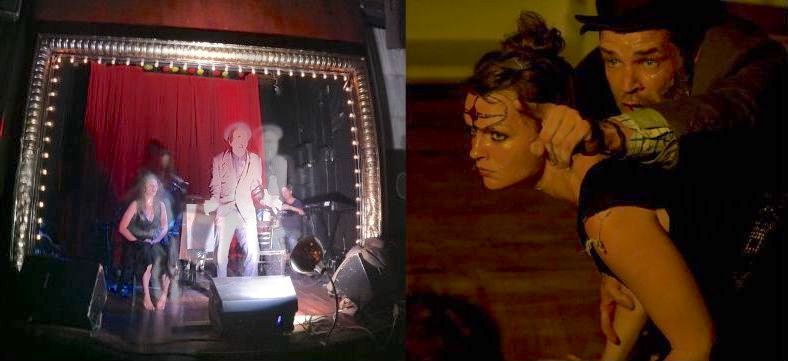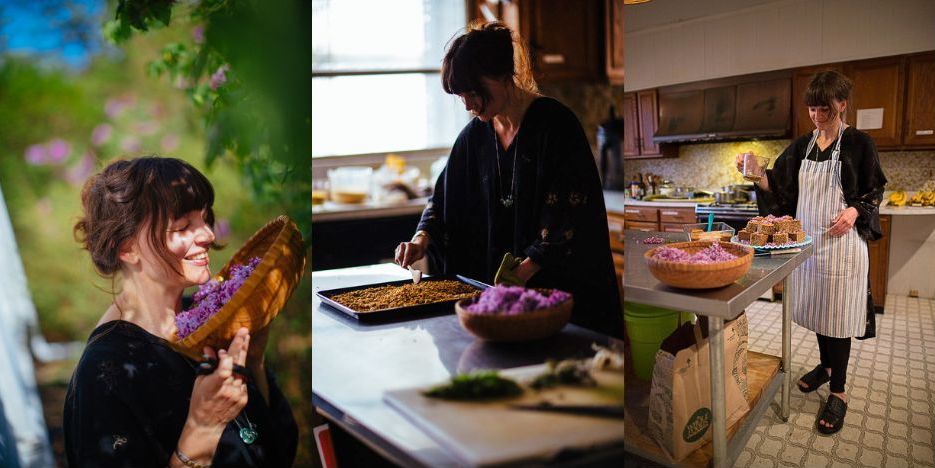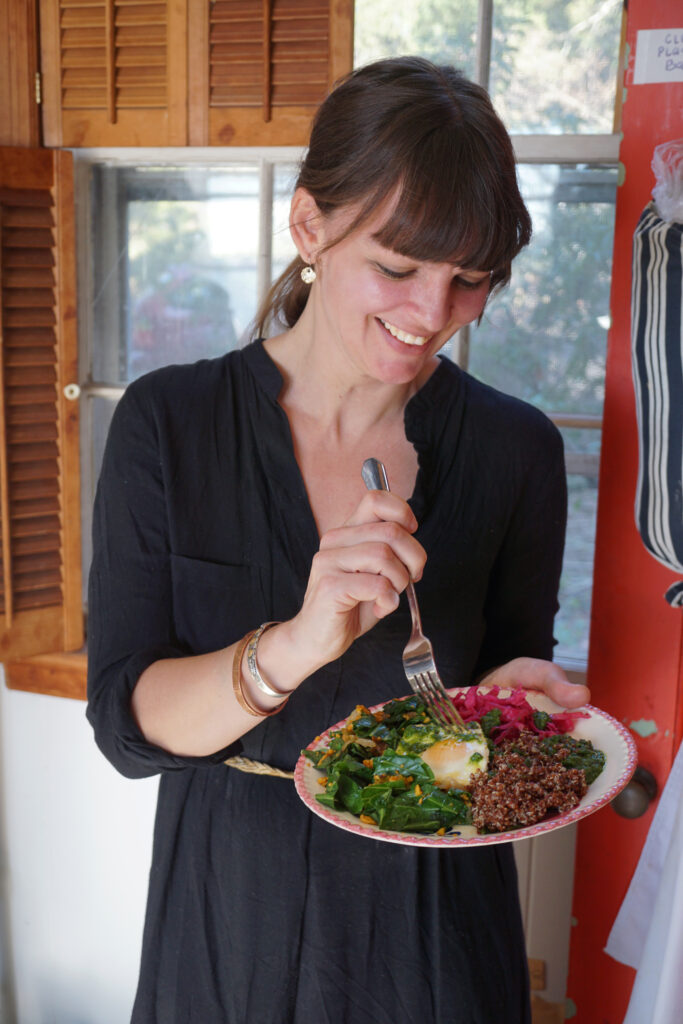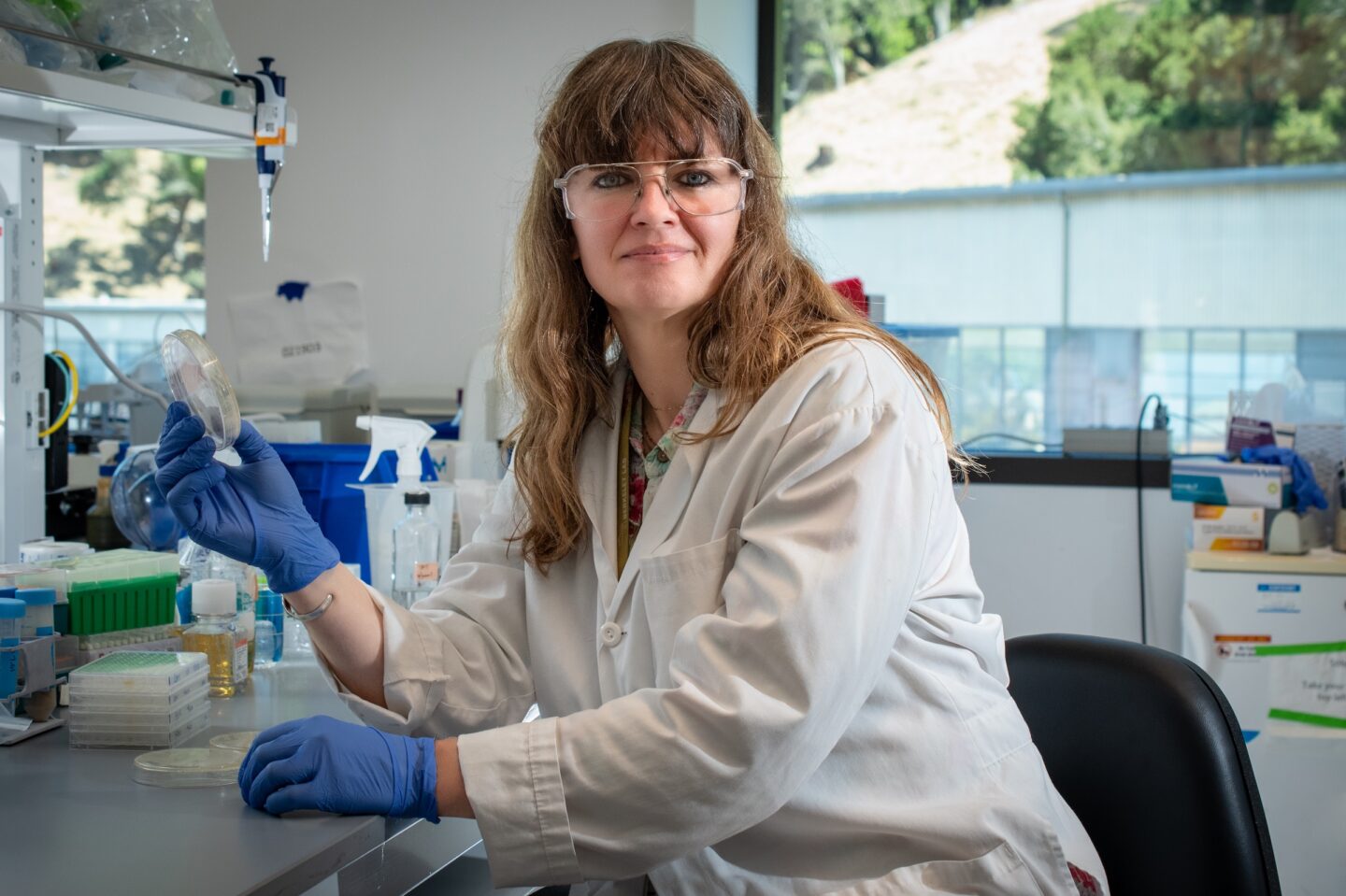From thermal vents at the bottom of the ocean to the highly polluted soils and groundwater surrounding the site where the first atomic bombs were tested, microbes have adapted to survive in virtually every environment on Earth.
“Biology is always happening, regardless of intense stress,” said Hira Lesea, a senior research associate in the Environmental Genomics and Systems Biology (EGSB) Division. “I draw a lot of strength from that.”
Lesea knows a thing or two about surviving, and thriving, under stress. She’s followed her enduring curiosity and creativity through turbulent circumstances, underground punk music scenes, tight-knit artist communities, and stints as a personal chef to her current role doing microbiology research in the lab of EGSB senior faculty scientist Adam Arkin.
While scientists know that microbes exist across all different types of environments—and that they are affecting important processes wherever they are present—much remains mysterious about which organisms are living in these places, what exactly they are doing there, or what they need to survive. The answers to these fundamental questions are key to understanding the vital role microbes play in the larger-scale cycling of minerals and nutrients, which impact waterways, agriculture, human health, and more.
Lesea’s focus is studying the microbial communities at the Oak Ridge Reservation in Tennessee, which has high levels of uranium and heavy metal contamination left over from the site’s use for the Manhattan Project in the 1940s. The work is part of the ENIGMA (Ecosystems & Networks Integrated with Genes and Molecular Assemblies) Science Focus Area, a broader consortium of research teams working to catalog the diversity of microorganisms in the contaminated soils and groundwater at Oak Ridge. Lesea receives samples collected from the site by her collaborators in Tennessee, and works to grow and isolate the microbes from those samples in the lab. She works with a team to analyze the DNA and identify which microbial species are present. Based on the conditions it takes to grow different microbes, Lesea can then draw conclusions about what specific organisms need to survive and flourish, and make guesses about how they’ve adapted to live in such an extreme place.
“Understanding some of the ‘dark matter’ of microbial function that’s out there could underlie a new picture of how microbes are in dialogue with the environment,” Lesea said.
Healing Arts
Like the microbes she studies, Lesea has direct experience with adaptation. Her childhood in Sacramento, California, in a tight-knit spiritual community didn’t offer much of a stable foundation. She found solace in an underground punk music scene based around concerts hosted in the back of a local bookstore. Inspired, Lesea started collecting records, DJing, and playing drums in a band.
“Music and community kept me sane, and helped me develop the kind of resilience that I would ultimately need to become a scientist later on,” said Lesea.
Still, Lesea sought something completely different to separate herself from the challenges of her upbringing. She struck out on her own, moving to New York at age 21. Her Brooklyn loft became the epicenter of collaborative art-making for a growing community of painters, sculptors, musicians, playwrights, and other creatives.

In the fruitful 15 years Lesea spent in Brooklyn, she tried out many ways of making a living. Cooking—especially cooking for lots of people—proved to be one of her major creative outlets, and turned into a profession over time. She became a retreat chef, preparing food for yoga and meditation intensives, and also a personal chef. But between the physical labor involved and being forced to move several times (as more and more of her affordable living options transformed into condos), Lesea felt the need for a change, craving stable, lucrative work that employed more of her intellect.


While cooking for different health- and wellness-based communities, she’d discovered that Ayurveda, a traditional medicine system that has been practiced in India for thousands of years, piqued her interest in a way that begged deeper exploration.
“Ayurveda sees food as our first medicine, and asks how what we’re eating affects the rest of our constitution and our health,” Lesea said. “What we eat feeds a whole community of bugs in our gut that we know almost nothing about. I wanted to understand the intersection of how people are impacted through what they eat—and potentially how that affects their emotional or psychological states.”
Lesea traveled to India to take a course in Ayurvedic principles, and then returned to California to go back to school and follow her budding interest in environmental microbiology.
New Recipes for Growth
To become a microbiologist after her long hiatus away from school, Lesea essentially had to start from scratch. She worked her way through introductory math and science courses at a community college—all while cheffing on the side to support herself—and ultimately transferred to UC Davis to complete the final two years of her bachelor’s degree in molecular and medical microbiology.
“When I started, I didn’t quite know what I was getting myself into,” said Lesea. “But having life experience under my belt made it easier for me to see the end goal and work to get there.”
In her first year at UC Davis, she landed a research internship working on a project with Jonathan Eisen, a well-established microbiome scientist, studying the anal sacs of domestic cats. The research was focused on exploring how cats send chemical signals to each other using odors derived from families of bacteria living in their anal glands. These specialized communities of bacteria work behind the scenes to drive commonly observed cat behaviors, like territorial marking and friendly butt-sniff greetings.
Though she was new to the bench, Lesea found her experiences as a chef made for an easy transition into the rhythm of lab work. Planning and preparing the media to grow a particular organism and iterating over a recipe of ingredient, temperature, and process conditions to get it just right felt instantly familiar to her.
“In the lab, like in the kitchen, you have to use all your senses, observe, and be detailed,” she said. E. coli, for example, has a distinctive smell, and Lesea sometimes smells culture plates to make sure they’re not contaminated.
Those parallels helped her fall in love with research. After finishing school, she had to choose between job options: one at a biotech company, and the other at Berkeley Lab. Her early experiences collaborating with her artist friends in Brooklyn made the team science focus of Berkeley Lab more attractive.
“Pursuing good work with people I care about and respect—that’s more valuable than anything, whether it’s art, music, or science,” Lesea said. “The work only gets better when we give each other input and understand together.”
Crossfeeding Creativity
With her nights spent in underground punk clubs largely behind her, Lesea now enjoys a quieter life. But she finds creative inspiration is still a frequent visitor. In between hours hiking with her dog or escaping into a juicy magical realism novel, she goes through phases of cooking with zeal, or taking trips to a local dark room to play around making prints of her old photography films and negatives. And she still enjoys listening to the eclectic records in her extensive collection.
“I don’t feel like creativity is about output; I think that’s an important pressure to keep off,” she said. “It’s really about: Is it feeding you, or giving you something that you need in that moment?”
Lesea seems to have struck the right balance to keep her creativity microbiome diverse and flourishing, providing a nourishing counterpoint that supports her in taking on new challenges in her research work at the Lab. In Fall 2025, she will begin pursuing her doctorate in comparative biochemistry at University of California, Berkeley. While her work will primarily consist of continuing her current projects in the Arkin Lab, she’s looking forward to getting more license to design her own experiments.
Part of why she’s committed to staying at Berkeley Lab for the long haul is the feeling of being surrounded by people who are not just bright and encouraging of her independent thinking, but who are also multidimensional and creative themselves.
“The best scientists are creative and collaborative, and that’s the community I have here at the Lab,” said Lesea.⬢
Written by Maritte O’Gallagher. As a communications specialist for Berkeley Lab’s Biosciences Area, O’Gallagher spotlights the people and stories behind our latest research.
Read other profiles in the Behind the Breakthroughs series.




